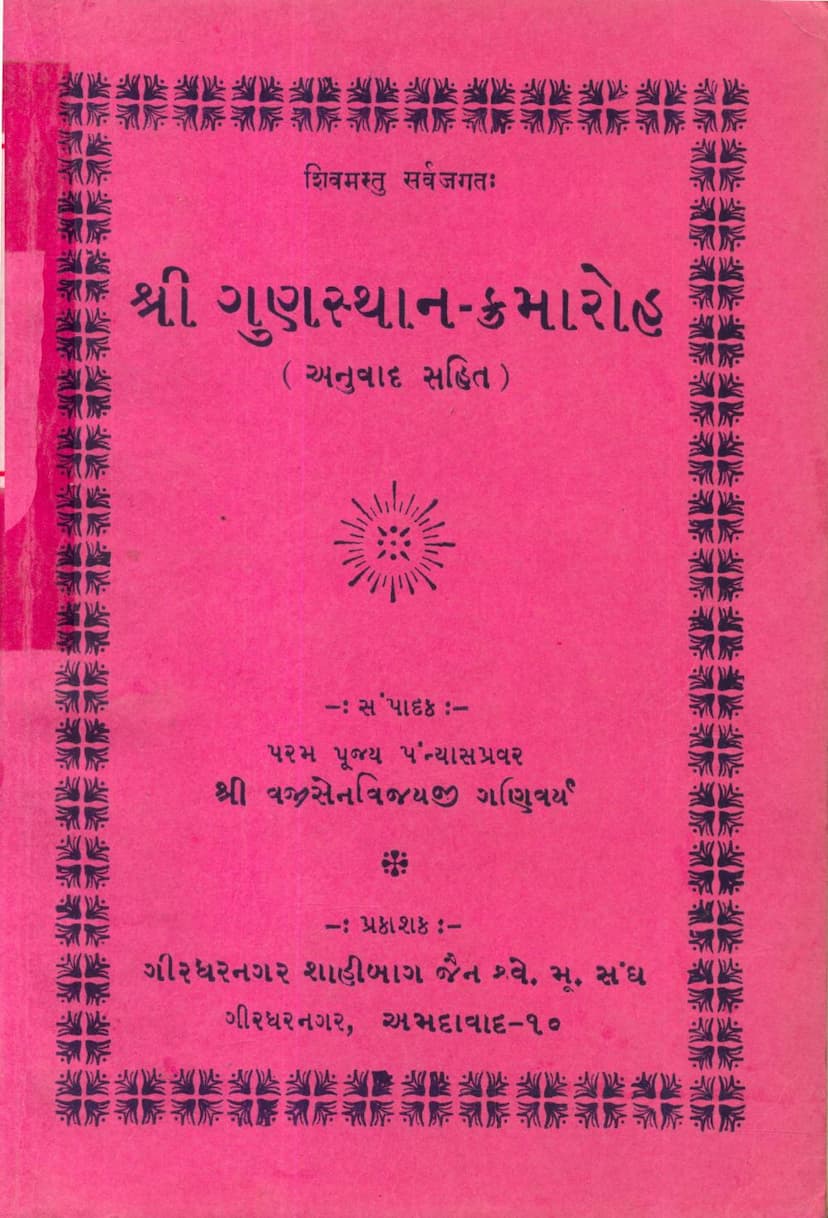Gunsthan Kramaroh
Added to library: September 1, 2025

Summary
This is a comprehensive summary of the Jain text "Gunsthan Kramaroh" by Vajrasenvijay Gani, based on the provided pages:
Book Title: Gunsthan Kramaroh (Stages of Spiritual Development) Author: Acharyadev Shri Ratnashekhar Suri Editor/Commentator: Param Pujya Pannas Pravar Shri Vajrasenvijay Gani Publisher: Girdharnagar Shahibaug Jain S M P Sangh
Overall Purpose: The book, "Gunsthan Kramaroh," is a treatise on the 14 stages of spiritual development in Jainism, known as Gunasthans. It explains the progressive spiritual journey of a soul from the lowest state of ignorance and delusion to the highest state of omniscience and liberation. The text, originally authored by Acharyadev Shri Ratnashekhar Suri, has been meticulously translated and elucidated by Shri Vajrasenvijay Gani to make it accessible to contemporary readers.
Key Themes and Content:
-
The 14 Gunasthans: The central focus of the book is the detailed exposition of each of the 14 Gunasthans. These stages represent the soul's gradual purification and advancement through the shedding of karmic bonds and the development of virtues. The text systematically explains the characteristics, progress, and challenges associated with each stage.
-
Spiritual Ascent: The title "Kramaroh" (ascending) signifies the journey upwards through these stages. The book emphasizes that this ascent is a difficult and arduous process, often described as walking on a sword's edge or climbing a mountain of ice. Even accomplished practitioners can falter on this path.
-
The Nature of Gunasthans: The book clarifies that each Gunasthan represents a specific state of the soul characterized by the intensity and nature of its passions (kashayas) and the presence or absence of right faith (samyaktva) and conduct (charitra). The progression from one Gunasthan to the next involves the weakening or destruction of certain karmic obstructions.
-
Karmic Processes: A significant portion of the text delves into the intricate workings of karma – specifically, bandha (bondage), udaya (fruition), and satta (dormant potential) – at each Gunasthan. Understanding these karmic processes is crucial for comprehending the soul's journey.
-
The Role of Acharyadev Shri Ratnashekhar Suri: The book highlights the contribution of Acharyadev Shri Ratnashekhar Suri, a prominent Jain scholar and spiritual leader from the 14th century Vikram era. It provides a brief biographical sketch, mentioning his lineage and literary works, including his commentary on the "Gunsthan Kramaroh." He is praised for his profound understanding and ability to dispel ignorance.
-
The Contribution of Shri Vajrasenvijay Gani: The editor, Shri Vajrasenvijay Gani, is lauded for his scholarship and devotion. His translation and commentary aim to simplify the complex concepts of the original text, making the spiritual path of the Gunasthans understandable and inspiring for the modern reader. His work is a testament to the Jain tradition of preserving and disseminating spiritual knowledge.
-
The Difficulty of the Path: The text repeatedly stresses the immense difficulty of traversing the Gunasthans. It uses strong analogies to illustrate this, stating that it is harder than walking on a sword, chewing iron nuts, crossing the ocean with two arms, or climbing a snowy mountain. The intricate nature of the progression, where one might skip certain intermediate stages or fall from higher stages, is also emphasized.
-
The War Between Soul and Karma: The book frames the journey through the Gunasthans as a fierce battle between the soul and its karmic coverings. Understanding the "Gunsthan Kramaroh" is presented as essential for those who wish to emerge victorious in this spiritual struggle.
-
The Importance of Knowledge and Interpretation: The text acknowledges the decline in the ability to understand ancient texts and highlights the role of modern scholars like Shri Vajrasenvijay Gani in translating and interpreting these valuable works. This act of disseminating knowledge is considered a form of "gyan-daan" (charitable giving of knowledge), which is deemed the highest form of charity.
-
Specific Gunasthans Discussed (Based on Index and Snippets):
- Mithyatva Gunasthan (1st): Deals with delusion, false faith, and its various types (abhigrahik, anabhigrahik, abhiniveshik, sanshayik, anabhogik). It explains how the soul is bound by false beliefs.
- Sāsvādan Gunasthan (2nd): The stage of tasting (brief enjoyment) of right faith, often experienced when falling from higher stages. It's a transitional state.
- Mishra Gunasthan (3rd): The mixed stage, where the soul experiences both right and wrong faith simultaneously due to the rise of mixed karma.
- Avirati Samyag-drishti Gunasthan (4th): Right faith without vows or full restraint. The soul has correct understanding but hasn't fully renounced worldly attachments.
- Deshvirati Gunasthan (5th): Partial restraint, where vows are undertaken by lay followers (shravaks). This stage involves ethical conduct and contemplation.
- Pramatta Gunasthan (6th): Careless stage, where a monk or nun experiences spiritual lapse due to the intensity of the fourth type of kashayas (sanjvalana) and various forms of negligence.
- Apramatta Gunasthan (7th): The stage of vigilance, where the monk or nun overcomes negligence and becomes more focused on spiritual practices.
- Higher Gunasthans (8th to 14th): These stages involve progressive purification, culminating in the destruction of all karmic obstructions, leading to Keval Gyana (omniscience) and Moksha (liberation). They are associated with advanced meditative states like "Shukla Dhyana" (pure meditation). The text details the processes of "Upasham Shreni" (path of subsidence) and "Kshapak Shreni" (path of destruction) that lead to these ultimate states.
-
Detailed Explanations of Meditation (Dhyana): The book also touches upon the different types of meditation, including Ārtta (suffering), Raudra (fierce), Dharma (righteous), and Shukla (pure) dhyana, and how they relate to various Gunasthans. It explains the prerequisites and techniques for achieving higher states of meditation.
-
Biographical Information: The text includes biographical details about the lineage of gurus and patrons, underscoring the historical and spiritual context of the work.
In essence, "Gunsthan Kramaroh" serves as a guide for Jain practitioners to understand the spiritual path, the obstacles they may encounter, and the ultimate goal of liberation. It is a profound exploration of the soul's journey toward purity and perfection.